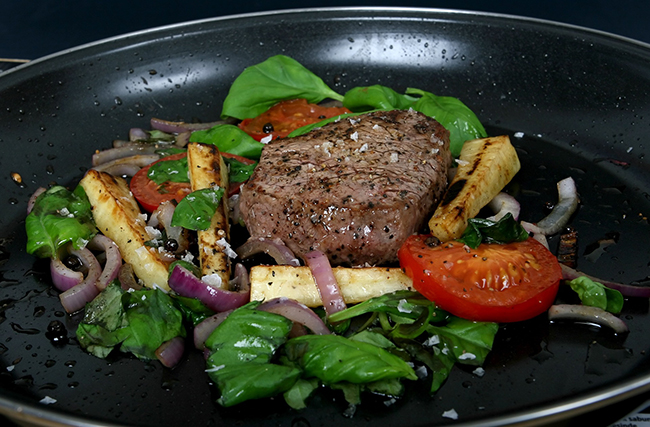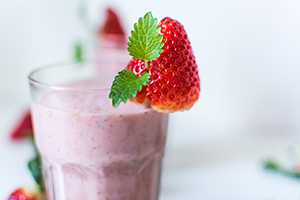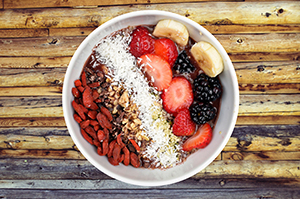5 Food Trends to Jump on this Season

By Kristen Carlucci, RD
Similar to fashion, every season a new crop of elite food and health trends begin to emerge. Some are fads that won’t stick around, while others are here to stay. Don’t waste time trying to figure out what foods to try and what to pass. We’ve done the work for you and compiled a list of the top five trends that will keep you looking younger, healthier, leaner, and more energized this season and all year long.

1. Drinkable Beauty.
Forget face masks and Botox to look years younger, the new trend is ingesting your skincare regimen. The celebrity nutrient being focused on is collagen, one of the richest proteins in the body and in charge of keeping our skin tight and smooth and hair strong and shiny. As we age, our body’s natural ability to produce collagen slows down, plus factors such as stress, sleep, and diet can interrupt this essential function. One study by the University of Kiel in Germany found that a group taking supplemental collagen had significantly higher content of procollagen type I (65%) and elastin (18%) than the placebo volunteers after just eight weeks proving that beauty does works from the inside out.
Trend How-To:
Add a scoop of collagen powder to your smoothies, morning coffee, or oatmeal. Or make your own homemade, collagen-rich drinkable broth by simmering 3-4lbs chicken or beef bones in 16 cups of water and 2 Tbsp of apple cider vinegar in a pot or slow cooker for 10 hours. Strain into a glass and skim the fat off the top before drinking. Don’t forget to incorporate collagen-boasting foods, such as salmon, dark leafy greens, berries, tomatoes, sweet potatoes, and berries into your diet.
2. Fermented foods.
Our intestinal health is interconnected with so many other functions in our body, including digestion, hormonal balance, immunity, nervous system, mood, and skin. Eating fermented foods—whole foods combined with salt or other natural microorganisms that change its composition—help keep our intestines healthy by helping our bodies digest and absorb nutrients better, increase the number of digestive enzymes, and rebuild a healthy gut environment.
Trend How-To:
Incorporate fermented foods gradually into your diet with sauerkraut, pickled vegetables, kimchi, miso, tempeh, kombucha, cottage cheese, and yogurt (look for yogurts that list “active cultures”). You can make your own sauerkraut at home by combining cabbage, salt, and caraway seeds in a mason jar and letting it ferment for three to ten days.
3. Grass-fed meats:
While most health organizations tell us to limit our intake of red meat, popular diets such as Paleo and Whole30 say it’s okay as long as it is the highest quality available. Enter Grass-fed meats. Animals who are fed a diet of grass, not grains, have a noticeable surge of anti-inflammatory Omega-3 fatty acids as compared to conventional meats and a much lower level of the inflammatory Omega-6’s. Grass-fed animals are also raised antibiotic and hormone-free and contain more vitamins A, B, and E, calcium, magnesium, and potassium than their grain-fed counterparts. An extra bonus: when you purchase this kind of meat, you are usually buying from smaller farms and supporting local agriculture.
Trend How-To:
If you do eat red meat in your diet, always try to buy grass-fed beef, lamb, or bison and keep your portion to 4-6oz. Grill up a grass-fed bison burger with avocado, red onion, lettuce, and tomato on a whole grain bun or check out one of the many New York City restaurants now using grass-fed meats in their menu, such as Bareburger, Brgr, and Tallgrass Burger.

4. Real Food:
Gone are the days of consumers wanting to buy only “fat free” and “sugar free” foods. Instead, what we want is more natural foods and less processed ingredients – and major food companies and fast food restaurants are starting to listen. Kraft, General Mills, Taco Bell, and Panera are some of the leaders now committed to removing artificial preservatives, flavors, colors, and sweeteners from their foods in an effort to improve the quality and boost sales. It’s a win-win situation: good for their wallets and good for our waistlines. Let’s hope even more companies will follow suit in this real foods movement.
Trend How-To:
Always check the ingredients list on any packaged foods. If it has more than 5-10 ingredients, or ingredients you have never heard of or can’t pronounce ditch it. Don’t be fooled by front-of-package labels like “all-natural” or “made with whole grains” as these claims can be deceiving. Instead, do the research yourself by checking out what is actually in the food you’re eating. When you cut out processed foods, you will be amazed at how much better you feel.
5. Veggie-centric meals:
A recent report from The World Health Organization (WHO) ranked cured and processed meats alongside smoking as one of the top causes of cancer. According to the report, eating as little as one slice of ham or three slices of bacon (50g of processed meats) a day could in fact increase your chances of developing colorectal cancer by close to 20%. With many people trying to reduce their intake of processed meat, vegetables are becoming the new superstar on the plate.
Trend How-To:
You don’t need to become a full-time vegetarian, but try to incorporate at least one meal a day or one full day a week that is plant-based. Find fun ways to incorporate more vegetables, such as roasting them in a little olive oil, topping them with herbs and spices, dipping them in hummus, or sneaking them into your favorite meals. Your Meatless Monday dish could be as simple as having a vegetable omelet or avocado toast for breakfast, 3-bean chili for lunch, and homemade veggie pizza for dinner. Make an effort to include vegetables at every lunch and dinner, so your meals are packed with nutrients and will keep you full and satisfied.



